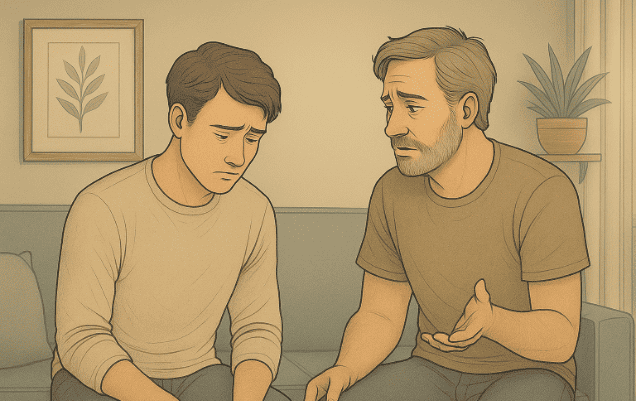Key Takeaways
- Schizoaffective disorder combines psychotic symptoms and mood episodes, making experiences unpredictable; hallucinations, delusions, and mood swings feel real and require patience and understanding.
- Creating a calm, low-stimulation environment and choosing the right time for conversation helps the person feel safe, focused, and willing to engage.
- Use clear, simple language, avoid arguments, match their communication pace, and practice active listening to validate feelings without reinforcing false beliefs.
- Respond to hallucinations and delusions with empathy, focus on underlying emotions, use gentle redirection, and seek support from family or caregiver groups when needed.
- Personalized, evidence-based programs like A Mission for Michele provide compassionate care, tailored therapy, and coordinated support, helping individuals manage symptoms, build resilience, and achieve meaningful recovery.
What Schizoaffective Disorder Looks Like in Real Life
Schizoaffective disorder combines symptoms of psychosis, such as hallucinations and delusions, with mood episodes of depression or mania. A person may hear voices, hold strong beliefs disconnected from reality, or shift between deep sadness and bursts of high energy.
Unlike schizophrenia, mood changes play a major and ongoing role, making the condition unpredictable from day to day. Imagine speaking with someone who’s distracted by voices only they can hear or whose thoughts move rapidly between unrelated ideas. Their experiences feel completely real to them, which can make everyday conversations confusing or emotionally intense, requiring patience and understanding from those around them.
Founded in 2010, A Mission For Michael (AMFM) offers specialized mental health care across California, Minnesota, and Virginia. Our accredited facilities provide residential and outpatient programs, utilizing evidence-based therapies such as CBT, DBT, and EMDR.
Our dedicated team of licensed professionals ensures every client receives the best care possible, supported by accreditations from The Joint Commission and the California Department of Health Care Services. We are committed to safety and personalized treatment plans.
Creating a Safe Space for Communication
Effective communication starts by ensuring the person feels safe, respected, and comfortable expressing themselves. The physical space, timing, and overall atmosphere all shape how well someone with schizoaffective disorder can engage.
People with this condition may process sensory input differently, what feels like mild background noise to you could be distressing to them. Too much visual or auditory stimulation can also make it hard for them to focus. Preparing a calm, thoughtful setting shows respect for their needs and strengthens trust.
Pick the Right Time and Place
Choose moments when the person seems stable and open to conversation. Some communicate best in the morning, others later in the day. Avoid serious talks during hallucinations, paranoia, or mood swings when processing information is difficult.
Remove Distractions and Noise
Select a quiet, private, and familiar setting. Turn off TVs, silence devices, and minimize interruptions. Use natural light if possible, and keep the space simple, too many visuals or sounds can be distracting.
- Choose a quiet spot with minimal background noise
- Silence phones and electronics
- Keep lighting soft and comfortable
- Avoid clutter or visual distractions
Stay Calm and Patient

Simple, clear language can make conversations less overwhelming for someone with schizoaffective disorder.
Your emotional tone sets the pace. People with schizoaffective disorder are often sensitive to others’ moods, so they maintain a calm, steady presence. Speak slowly, allow time for responses, and stay patient even when pauses occur. These breaks aren’t disinterested—they’re moments to process and refocus, showing that you value their comfort and trust.
The Best Ways to Speak and Listen
Communicating effectively with someone who has schizoaffective disorder depends on how you speak and listen. Tone, phrasing, and genuine attention help build trust and connection. The person is more than their symptoms—they deserve the same respect and patience as anyone else.
Good communication isn’t about correcting their thoughts but creating understanding and helping them feel heard and valued.
Use Clear, Simple Language
Keep your words straightforward and concrete. Avoid metaphors, idioms, or complex phrasing that might confuse or overwhelm. Break ideas into smaller steps and speak in short, clear sentences. When sharing important details, offer both verbal and written reminders if possible. Gently check for understanding without making the person feel tested.
Avoid Argumentative Tones
Stay calm and collaborative, even if you disagree. Arguments or corrections can heighten distress. Try responses like, “I understand that’s how you see it,” or “I see it differently, but I respect how you feel.” Your facial expressions and body language matter too—relaxed posture and a kind tone help convey support and safety.
Match Their Communication Pace
Follow their rhythm. Don’t rush if they need time to think or speak. If they’re speaking quickly or jumping topics, guide the discussion gently without interrupting. Processing time varies, so allow pauses, they may simply be organizing their thoughts.
Practice Active Listening Without Judgment
Give your full attention. Maintain gentle eye contact, nod, and use affirmations like “I hear you.” Reflect their feelings to show understanding: “It sounds like you’re frustrated about that.” Even when their experiences seem unreal to you, acknowledge the emotions behind them. Validating their feelings, without reinforcing false beliefs, builds trust and empathy.
How to Respond to Hallucinations and Delusions
Supporting someone during a psychotic episode requires calm, empathy, and understanding. Hallucinations (seeing or hearing things others don’t) and delusions (firm false beliefs) feel completely real to the person experiencing them. Your role isn’t to correct these symptoms but to provide reassurance, reduce distress, and maintain a sense of safety and connection.
These experiences are serious symptoms of a medical condition. Responding with patience and compassion acknowledges their reality while preserving trust.
Don’t Argue or Dismiss Their Reality
Directly challenging a hallucination or delusion (“That’s not real”) can increase fear or isolation. Instead, validate the emotional experience without confirming the content: “I understand you’re hearing voices, and that must feel overwhelming.” If asked whether you experience the same, respond gently: “I don’t hear them, but I believe that you do, and I’m here to support you.” This balanced approach maintains credibility while showing respect.
Focus on the Feelings Behind the Experience
Often, addressing the underlying emotions, fear, confusion, or anxiety is more effective than debating the delusion itself. For example: “That sounds frightening, how are you coping with those feelings?” Empathy helps them feel seen and understood without reinforcing false beliefs, which can strengthen trust and make conversations less stressful.
Gently Redirect When Needed
If hallucinations or delusions dominate a conversation, use subtle transitions: “I hear what you’re saying about the voices. Speaking of that, did you enjoy the music yesterday?” Engaging in shared, concrete activities, like taking a walk, doing a puzzle, or cooking, can help ground them in the present while providing natural redirection.
Join Support Groups
Family and caregiver support groups provide practical tips, emotional guidance, and community understanding. Connecting with others in similar situations can reduce feelings of isolation and provide insight into coping strategies that work.

Family involvement and community connection play a key role in sustainable mental health recovery.
Know When to Step Back
Recognize when you’re becoming emotionally overwhelmed. Temporary distance, while arranging alternative support, is not abandonment but self-care. Prioritize rest, enjoyable activities, and stress management to maintain your ability to provide consistent, compassionate support over time.
This approach balances empathy, safety, and practical strategies, helping both you and the person with schizoaffective disorder process challenging moments more effectively.
Crisis Communication: What to Do in Emergencies
Even with careful planning, mental health crises can happen. Being prepared allows you to respond calmly and help your loved one stay safe. Have emergency contacts ready, know what counts as a true crisis, and practice basic de-escalation strategies before an episode occurs.
Warning Signs of a Mental Health Crisis
Early recognition can prevent escalation. Warning signs include disorganized thinking, intense agitation, refusal to eat or take medication, worsening hallucinations or delusions, and severe sleep disturbances. Noticing these signs early allows you to intervene before the situation becomes dangerous.
Who to Call for Help
Keep emergency numbers easily accessible. Options include the 988 Suicide & Crisis Lifeline, Crisis Text Line, NAMI HelpLine, local psychiatric services, and 911 (requesting a Crisis Intervention Team officer). Provide clear information about the person’s condition, symptoms, and medication history. If safe, remove any dangerous items while waiting for help.
What to Say During a Crisis
Speak in calm, simple sentences and maintain a gentle tone. Avoid sudden movements or rushing the person. Short statements like “I’m here with you” or “I want to help” provide reassurance. Focus on immediate safety rather than resolving underlying issues, which can be addressed once the crisis is over.
Discussions About Medication and Treatment
Open conversations about medication and treatment are essential for supporting someone with schizoaffective disorder. Approaching these discussions thoughtfully can improve adherence, address concerns, and strengthen trust between you and your loved one.
How to Discuss Medication Compliance Sensitively
Approach the topic gently and without judgment. Ask open-ended questions like, “How are you feeling with your current medication?” Emphasize understanding their experience and challenges rather than focusing solely on whether they are taking medication correctly.
Supporting Treatment Adherence Through Communication
Encourage consistency by framing treatment as a tool to help them achieve personal goals and maintain stability. Positive reinforcement and celebrating small steps can make adherence feel collaborative rather than controlling.
Talking About Side Effects and Treatment Concerns
Invite them to share any side effects or worries openly. Validate their experiences, and avoid minimizing discomfort. Discussing concerns honestly helps maintain trust and ensures they feel heard and supported in decision-making.
Coordinating with Healthcare Providers
With their consent, keep communication open with doctors, therapists, or case managers. Coordinated care allows for timely adjustments, ensures concerns are addressed professionally, and helps the person feel more confident in their treatment plan.
Empowering Recovery with A Mission for Michele

AMFM provides personalized care for complex mental health conditions like schizoaffective disorder.
When supporting someone with schizoaffective disorder, access to compassionate, personalized care can make all the difference. A Mission for Michele (AMFM) provides specialized programs designed to address complex psychiatric conditions while fostering stability and long-term wellness.
Tailored Treatment for Schizoaffective Disorder
AMFM offers residential, partial hospitalization, and outpatient programs for adults managing schizoaffective disorder, mood disorders, and co-occurring conditions. Our approach blends evidence-based therapies like CBT, EMDR, and ACT with holistic options such as art and experiential therapy, addressing both symptoms and underlying challenges.
Compassionate, Individualized Support
With a 2:1 staff-to-client ratio, licensed clinicians provide attentive care, creating safe, home-like environments. Each treatment plan is personalized, ensuring that individuals feel seen and understood beyond their diagnosis, while building skills for daily life and emotional resilience.
Accessible and Coordinated Care
AMFM helps process insurance and treatment logistics, offering programs in multiple states and telehealth options. Coordination with healthcare providers ensures consistent support, helping clients maintain treatment adherence, manage symptoms, and respond effectively to challenges.
Empowering Clients and Families
Beyond therapy and medication management, AMFM emphasizes connection and practical skills. Family involvement, experiential learning, and individualized coaching empower clients to cope with hallucinations, mood swings, and daily stressors while promoting independence and meaningful recovery.
Frequently Asked Questions (FAQs)
How do I tell the difference between normal behavior and symptoms of schizoaffective disorder?
You might notice significant changes from the person’s usual behavior, such as sudden paranoia, extreme mood swings, or shifts in sleep, hygiene, and social engagement. Recognizing patterns helps you respond supportively before symptoms escalate.
Is it okay to ask someone about their schizoaffective disorder?
Yes, but approach with sensitivity during stable periods and private settings. Ask from genuine curiosity to understand and support them, respect boundaries, and listen without judgment if they choose to share their experiences.
How do I help someone who refuses treatment for their schizoaffective disorder?
Listen without judgment to understand reasons for refusal. Build trust, provide information on alternative treatments, connect with peer support, and suggest help aligned with their personal goals, using involuntary treatment only as a last resort.
What should I do if I feel scared or uncomfortable during a conversation?
Prioritize your safety and emotional wellbeing. Step back if necessary, use grounding techniques, and take breaks. Recognize personal triggers, seek support if needed, and maintain self-care to continue providing effective support.
Can someone with schizoaffective disorder live a normal life?
Many people lead fulfilling lives with careers, relationships, and personal goals. Consistent treatment, therapy, and strong support networks improve outcomes, allowing individuals to focus on meaningful achievements.
Programs like A Mission for Michele (AMFM) offer personalized care and evidence-based therapies, helping clients manage symptoms, build resilience, and maintain stability, so living a meaningful, goal-oriented life becomes more attainable.












